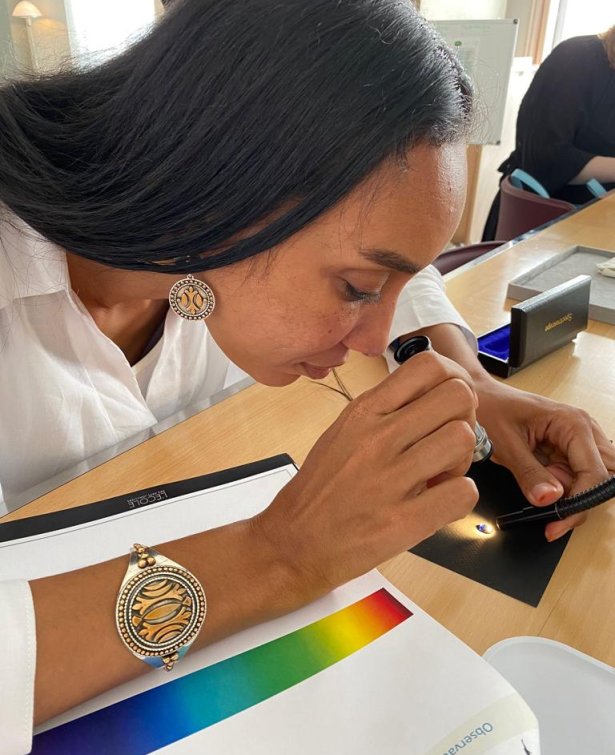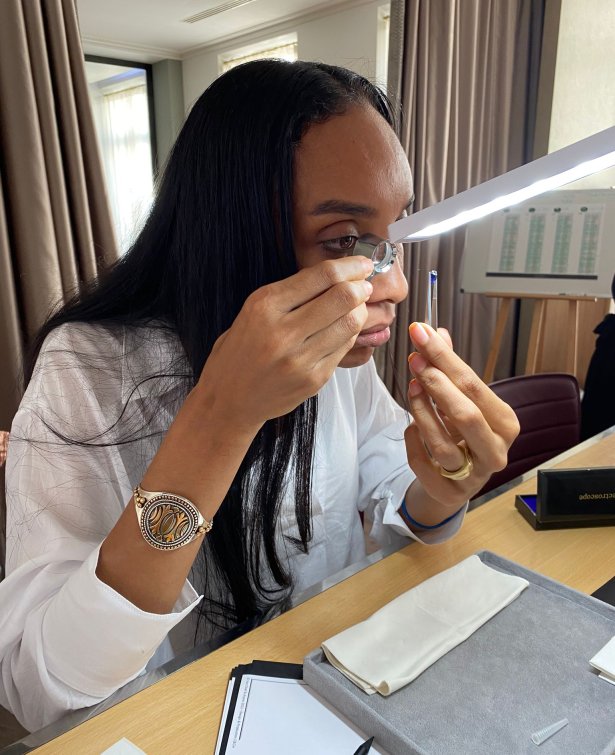Interview with Nisreen Kuku
Sudanese jewelry designer and interior design engineer
Let's get to know her better!
Nisreen Kuku is a Sudanese jewelry designer and interior design engineer. She is also the founder of the design house Kuku.
Nisreen was born and raised in Omdurman city, state of Khartoum, Sudan. She graduated from Omdurman Ahlia University in Khartoum, with a Bachelor of Arts in Interior Design in 2002. From an early age, she started collecting antique jewelry from the Omdurman old market and from prominent antique sellers. These old pieces became an inspiration for her work. Nisreen was the first female jewelry designer in Sudan, dating back to early 1996.
Nisreen Kuku focuses on producing jewelry inspired from Sudanese culture, heritage, and history. Through research, she identifies cultural jewelry, dresses, ornaments, and habits, and in turn, she designs custom jewelry based on these artefacts. Kuku gallery has participated in various cultural exhibitions and research projects, which helped in identifying Sudan’s diverse heritage and cultural traditions.
In July 2022, in collaboration with the French Embassy in Sudan, we are delighted to welcome Nisreen Kuku to L'ÉCOLE in Paris in for a series of classes, as well as a guided tour by our historians at the Musée des Arts Décoratifs. Inezita Gay-Eckel, historian and lecturer at L'ÉCOLE, has taken the opportunity to have a dialog with her as follows.
All photos © L’École Van Cleef & Arpels. Photographer: Pauline de Courrèges
You have been focusing on making jewelry inspired from Sudanese culture, heritage, and history.
There are more than 500 tribes in my country Sudan, with stories behind every single piece of jewelry. To keep these stories and pieces for the next generation, I have started doing proper research and documentation.
How and why are you saving old, traditional jewelry pieces? How are you documenting the social history surrounding them?
People in Sudan melt down jewelry for economic reasons, and this is a big problem. That's why I started collecting old jewelry and also the stories behind each piece. This has become my passion and my ambition: to conserve them for the next generations.
Usually, the same jewel is passed down for many generations. It is important to document it quickly, collect information from the owners. In order to do this, one may need to pay them money or ask them to keep the jewels in the museum. Sometimes the owners may not accept, and this brings to multiple negotiations.
I started my research in eastern Sudan and northern Sudan, and now I am working on western Sudan. I do my research by interviewing people from the tribes, always more than one person, to be sure to recollect and transmit the true story to future generations.
Four years ago, I opened a private museum to protect the jewels from being melted down. I am running this initiative alone with my financial means. Hopefully the government will support me later on. I love old jewelry, I spent a long time looking at them and I love sharing this passion with the others. I am very happy when I see the others learn something from them!
Can you give us an example? For instance, these bracelets that you're wearing, would those be part of a marriage ceremony? Would those be a dowry, a gift to the bride? Would those be something for a mother or a married woman?
In our Sudanese culture, on the wedding day, we have to give the bride a quantity of jewels. Every Sudanese tribe has its own iconic pieces [for weddings]. They name it by specific names. There are a lot of imaginations and stories behind every single piece. For example, to keep the bride and the groom from “the black eyes” [evil eyes], some of the tribes present silver. The eastern tribes of Sudan wear silver for example.
There are very beautiful stories behind each piece. The northern Sudanese, the Nubians, love gold. On the wedding day, the groom may have to bring three full sets of gold jewelry to the bride. And there is a Henna Party the day before the wedding, where the people usually bring sets of [gold] bracelets. The mother, the aunt, everyone has to come with a present for the bride. The bride keeps these old jewelry pieces for her children. So it has become like stories being transmitted from generations to generations by the mothers.
In eastern Sudan, people wear more silver, like silver chokers; and they decorate their hair instead of their hands.
In the north, in Nubia, the woman has to wear jewelry all the time. If she loses her husband, she has to wear jewelry upside down, "Jakid Necklace", to say she is not feeling good. Jewels are not just for the wedding, they accompany you for the whole life.
The western Sudanese wear more shells and beads, and corn. The shells are traded from the seaside in the East and the beads come from India. Normally beads are used for dresses.
You have dozens of drawings, you’re a prolific jewelry designer. Where do your inspirations come from?
I look at good jewelry design all the time. I cannot stop looking at the good work behind every piece.
When I went to school, I learned more from a designer’s point of view. I learned more about the history of international jewelry, the new techniques of using tools, drawings, and gemology.
Have you heard of L’ÉCOLE, School of Jewelry Arts before? After taking an array of courses at L’ÉCOLE across gemology, savoir-faire and history, what do you think of our course content as well as our pedagogy?
I learned a lot about the history of jewelry worldwide at L’ÉCOLE.
It was also the first time for me to properly attend a jewelry design class. I have never learned jewelry design before. I took the breadth and depth of what people had done through history to inspire my work. I started looking at my own country’s jewelry and keeping the aesthetics alive. I studied interior design after jewelry design. Interior design helped me to focus on proportion, contrast, texture, matching of materials.
I got to know about L’ÉCOLE thanks to the French embassy. I would have loved to have more time to practice with the jewelry tools at a L’ÉCOLE class! When I published my Instagram stories taken in L'ÉCOLE, many of my followers asked me about the school, its courses and registration. Probably in the future you could introduce Masterclasses. And next time, I would like to bring Leila, my daughter, to attend a kid’s workshop!
A Focus on Nisreen Kuku's Design
Eastern Sudan inspiration: Shottal Set
In "Dim Arab" market in Port Sudan city, eastern Sudan, swords are manufactured and artistic touches are added to its sharp blade. The Beja man is keen to wear a belt made of leather called “Kamar”, which he takes as a wallet for money and daggers. The handle of the daggers is made of ebony wood and decorated with silver, and the knife is made of recycled iron.
There are three types of daggers in terms of shape:
- The first (Khangar) with a straight head
- The second a (knife) with a curved head (the smallest of the three)
- The third “Shottal” which is straight and its top is pointed
The idea of the ornaments is inspired by the dagger of the from Beja people of eastern Sudan (Hadandawa Tribes). The name Shottal is one of their famous Daggers (the sharp end cover of the Dagger is usually made of copper or silver by talented goldsmiths).
The name “Shottal” is the name of the most famous dagger among the Beja tribes due to its distinctive shape.
Beja Collection: Shottal Set (necklace & a pair of earrings).
Northern Sudan inspiration: Jakid Set
The "Jakid" necklace is one of the most important necklaces in the Nubian bride’s dowry. It usually consists of six rounds, flat, and devoid of decorations. The diameter of the disc ranges between 26-38 mm, and each disc has a cylindrical hole similar to the barrel. It is prominent and is arranged with a thread to hide the place where it hangs and does not appear. The main purpose of this method is to project the disks as if they were flying planets suspended by themselves in space and shining with their light and golden rays.
In the middle of these six disks is a central round medallion called “Masha Allah” with inscriptions on it. Prominent, similar to a lotus flower, and its diameter ranges between 35-70 mm. These discs are interspersed with small conical beads of gold and it is possible to trace their insistence on using the circular shape or the uniform disc representing the sun disc.
One of the Nubian traditions is that a widowed woman does not wear jewellery after the death of her husband except one piece of jewelry, the “jakid” necklace, which is part of her marriage apparatus. However, after the death of the husband, she wears it lying backwards on the back instead of her chest.
Nubian Collection: "Jakid Set" (ring, necklace, earrings & cuff).
Sudanese Tribes' inspiration: Mirward Set
The idea of this jewel was inspired by the silver square prayer box of the Rashida tribes.
They are made in square, rectangular and cylindrical shapes, they have different sizes, they are made of leather or silver.
The prayer box has been used as an amulet to keep safe from fear and evil eye. It contains Islamic texts and supplications or magical writings to protect the wearer from envy, witchcraft, and the evil eye which are often written by the faqih.
The leather veil is worn in daily life on the upper arm of women and men more widely or even on the waist of a children. The family can hang it in the house entrance with the purpose of preservation.
Silver veils are made of silver by talented silversmiths and decorated with a range of different geometric shapes and granulation techniques in the form of necklaces placed on the neck, often with a one-sided cap to open and position the texts.
Most of the time it is solid, for example, the square veil is a representation of the Holy Quran, in their belief that they seek blessings and turn to the Quran.


